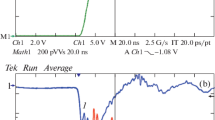Abstract
There are many types of non-thermal discharge devices that have been investigated for environmental applications. The potential of these devices for the destruction of pollutants or toxic molecules has already been demonstrated in several contexts, such as NOx and SO2 in power plant flue gases [Dinelli et al. 1990; Frank and Hirano 1990] and diesel engine exhaust [Higashi et al. 1992], heavy metals [Masuda et al. 1987] and volatile organic compounds [Yamamoto et al. 1992] in industrial effluents, and chemical agents such as simulated nerve gases [Fraser et al. 1985]. These devices operate on the same basic principle: produce a discharge in which a majority of the electrical energy goes into the production of energetic electrons, rather than into gas heating. Even though the electrons are short-lived under atmospheric pressure conditions and rarely collide with a pollutant molecule, they undergo many collisions with the dominant background gas molecules, thus producing radicals that, in turn, decompose the toxic compounds. The efficiency of the approach arises from the fact that the radicals have long lifetimes and react selectively with the contaminant molecules.
Access this chapter
Tax calculation will be finalised at checkout
Purchases are for personal use only
Preview
Unable to display preview. Download preview PDF.
Similar content being viewed by others
References
Alston, L. L (1968), High Voltage Technology (Oxford University Press, London).
Atkinson, R. (1986), “Kinetics and mechanisms of the gas-phase reactions of the hydroxyl radical with organic compounds under atmospheric conditions,” Chem. Rev. 86, 69.
Civitano, L. (1993), “Industrial application of pulsed corona procesing to flue gas,” in this volume.
Dinelli, G., Civitano, L., and Rea, M. (1990), “Industrial experiments on pulse corona simultaneous removal of NOx and SO2,” IEEE Trans. Ind. Appl. 25, 535–541.
Frank, N. and Hirano, S. (1990), “The electron beam flue gas treatment process,” Radiat. Phys. Chem. 35, 416–421.
Fraser, M. E., Eaton, H. G., and Sheinson, R. S. (1985), “Initial decomposition mechanisms and products of DMMP in an AC discharge,” Environ. Sci. Tech. 19, 946.
Higashi, M., Uchida, S., Suzuki, N., and Fujii, K. (1992), “Soot elimination and NOx and SOx reduction in diesel-engine exhaust by a combination of discharge plasma and oil dynamics,” IEEE Trans. Plasma Sci. 20, 1–12.
Maezawa, A. and Izutsu, M. (1993), “Application of e-beam treatment to flue gas cleanup in Japan,” in this volume.
Masuda, S., Wu, Y., Urabe, T., and Ono, Y. (1987), “Pulse corona induced plasma chemical process for DeNOx, DeSOx and mercury vapour control,” Proceedings of the 3rd International Conference on Electrostatic Precipitation, (October 1987, Padova, Italy) pp. 667–676.
Mizuno, A., Chakrabarti, A., and Okazaki, K. (1993), “Application of corona technology in the reduction of greenhouse gases and other gaseous pollutants,” in this volume.
Tokunaga, O., Namba, H., and Hirota, K. (1993), “Experiments on chemical reactions in electron beam induced NOx/SO2 removal,” in this volume.
Yamamoto, T., Ramanathan, K., Lawless, P. A., Ensor, D. S., Newsome, J. R, Plaks, N., and Ramsey, G. H. (1992), “Control of volatile organic compounds by an AC energized ferroelectric pellet reactor and a pulsed corona reactor,” IEEE Trans. Ind. Appl. 28, 528–534.
Author information
Authors and Affiliations
Editor information
Editors and Affiliations
Rights and permissions
Copyright information
© 1993 Springer-Verlag Berlin Heidelberg
About this paper
Cite this paper
Vogtlin, G.E., Penetrante, B.M. (1993). Pulsed Corona Discharge for Removal of NOx from Flue Gas. In: Penetrante, B.M., Schultheis, S.E. (eds) Non-Thermal Plasma Techniques for Pollution Control. NATO ASI Series, vol 34. Springer, Berlin, Heidelberg. https://doi.org/10.1007/978-3-642-78476-7_15
Download citation
DOI: https://doi.org/10.1007/978-3-642-78476-7_15
Publisher Name: Springer, Berlin, Heidelberg
Print ISBN: 978-3-642-78478-1
Online ISBN: 978-3-642-78476-7
eBook Packages: Springer Book Archive




